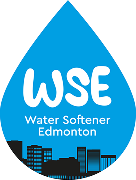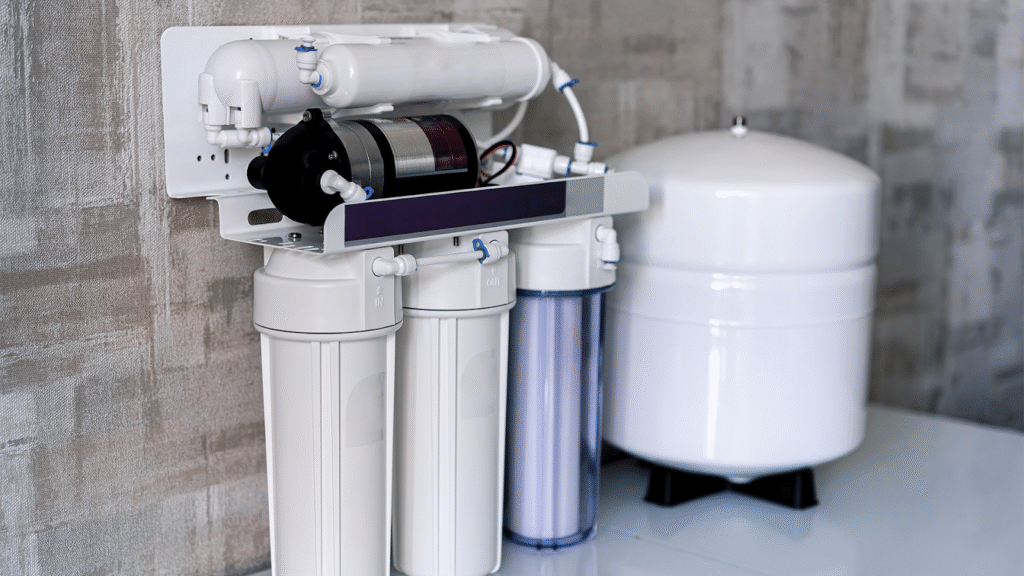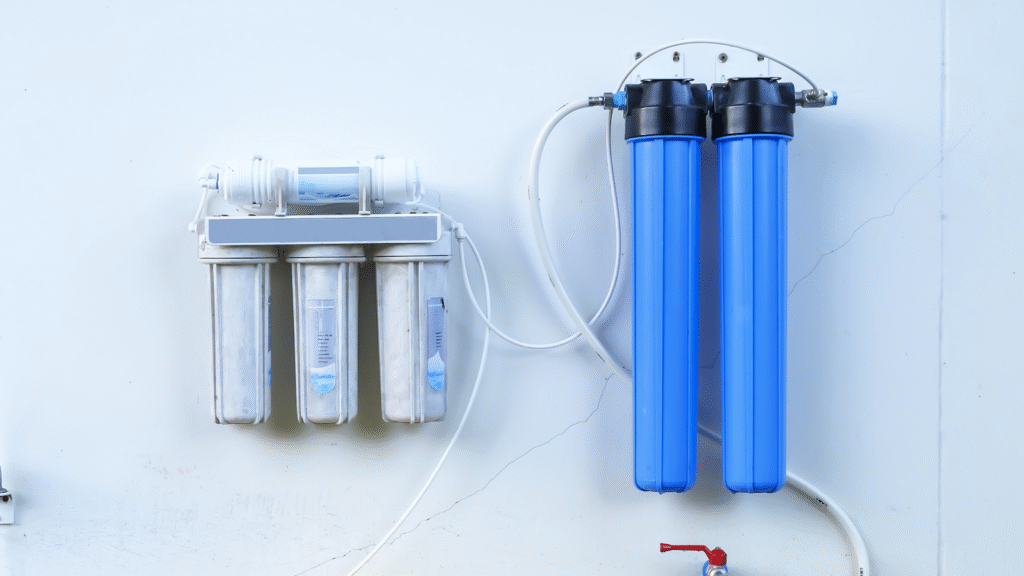You’ve finally decided to invest in a water softener but now comes the real challenge: water softener installation.
In Edmonton, where water hardness is more than just a minor nuisance, the way you install your system can determine whether it lasts 5 years or 15, whether it saves you money or quietly costs you hundreds in hidden inefficiencies.
A water softener is a part of your plumbing ecosystem, your home’s long-term health, and your family’s daily comfort. Unfortunately, many Edmonton homeowners make the mistake of assuming that installation is either a DIY-friendly task or a one-size-fits-all service. It’s not!
This guide walks you through the entire journey, from identifying the need for a softener to choosing the right installer and avoiding the costly missteps most people make. Whether you’re renovating, moving, or simply upgrading, this is your must-read blueprint for smart, future-proof installation.

Table of Contents
ToggleEdmonton’s Hard Water: The Real Cost of Doing Nothing
Edmonton’s Water Profile (And Why It Matters)
According to EPCOR, Edmonton’s municipal water averages 160–170 mg/L of calcium carbonate, placing it in the “hard water” category. This isn’t just a fun fact; it’s the root cause of:
- Scale buildup in pipes
- Shortened water heater lifespans
- Stiff laundry and soap scum
- Dry, irritated skin and hair
Over time, untreated hard water reduces your plumbing’s efficiency, increases utility bills and damages appliances like dishwashers and water heaters.
To understand more about how different water treatment technologies handle Calgary’s unique hardness, read our guide: Water Softener Technologies Guide in Edmonton
What Happens When You Skip Proper Installation?
Many homeowners purchase a high-quality water softener, only to install it improperly or in the wrong location, leading to:
- Drainage violations
- Improper regeneration cycles
- Bypass failures
- Voided warranties
In short: The best softener can underperform or fail if installed incorrectly.
DIY vs Professional Install, What’s Really At Stake?
Let’s address the elephant in the basement: Should you do it yourself?
The Allure of DIY
YouTube makes it look doable. A few hoses. A bypass valve. A bag of salt. You’re good to go, right?
Here’s the reality:
Common DIY Risks:
- Cross-connection to hot/cold lines
- Improper drainage slope or air gap installation
- Sizing errors (wrong grain capacity)
- Failing to meet local plumbing codes
Most importantly? If your system floods or fails, your home insurance might not cover it if you installed it yourself.
The Professional Difference
Licensed installers not only know Edmonton’s plumbing code, they understand your home’s specific needs:
- Type of water heater (tank or tankless)
- Basement vs garage placement
- Bypass valve optimization
- Water pressure balancing
For a deeper dive into how advanced softening alternatives like TAC systems work, see: Template Assisted Crystallization (TAC) Systems
Do You Even Need a Softener? Signs to Watch For
Before you book an installation, confirm that softening is the right solution for your water. Here’s how to find out:
Signs You Need a Softener
- White, chalky deposits on faucets and glassware
- Dry, itchy skin and brittle hair, especially in winter
- Faded clothes and stiff towels after washing
- Frequent appliance breakdowns (especially kettles and dishwashers)
- Lack of soap lather despite using more detergent
How to Know for Sure
Book a free water test with a reputable provider in Edmonton. Alternatively, you can buy a home testing strip kit (available at most hardware stores). You’re looking for hardness above 120 mg/L (7 GPG).
What a Proper Installation Looks Like, Step-by-Step
Professional water softener installation in Edmonton typically includes the following steps:
1. Assessment & Planning
- Where will the unit go? Basement? Utility room? Garage?
- Where’s the main water line and electrical outlet?
- Is there an accessible floor drain?
2. Shut-Off & Cut-In
- Water shut-off and pressure relief
- Cutting into the main supply line with copper or PEX
3. Bypass Valve Installation
- So water can bypass the softener during maintenance
- Ensures you can still access water during repairs
4. Drainage & Overflow Setup
- Install drain lines for brine discharge (must have air gap)
- Setup for brine tank overflow protection
5. Programming & Configuration
- Set regeneration cycles based on your household usage
- Input grain capacity and water hardness levels
6. Final Inspection & Test Run
- Check for leaks, test soft water output
- Ensure correct regeneration schedule is saved
The Hidden Rules, Permits, Plumbing Codes, and Drain Line Violations
Installing a water softener in Edmonton may seem simple, but it’s not always straightforward from a compliance perspective.
Plumbing Code Highlights:
- Air Gap Requirement: Your discharge line must have an air gap to prevent cross-contamination
- Drain Slope: The brine drain must have proper slope and elevation
- Pressure Regulating Valve (PRV) may be required depending on your home’s water pressure
Failing to follow these rules can result in:
- Fines during home inspections
- Insurance issues in case of water damage
- Contamination risks to the municipal water supply
What Makes a Good Installer in Edmonton? (And What to Watch Out For)
Choosing the right installer is just as important as choosing the right softener. Here’s how to find someone you can trust.
Questions to Ask:
- Are you licensed and insured for plumbing work in Alberta?
- Do you offer a warranty on installation labor?
- Have you installed systems in homes similar to mine (size, water source, layout)?
- Do you handle permits or inspections, if required?
Red Flags:
- Vague pricing or “flat rate” quotes with no breakdown
- No official business address or warranty details
- Pressure to upsell unnecessary filters or upsized systems
Aftercare Matters, What to Do After Installation
The first 48 hours after installation matter more than most people realize.
Immediate To-Dos:
- Check for leaks around connections
- Fill brine tank with salt (or potassium chloride)
- Manually trigger the first regeneration cycle
Ongoing Care:
- Monthly: Check salt levels and replenish
- Quarterly: Clean brine tank, check for salt bridges
- Annually: Replace pre-filter (if installed), sanitize resin tank
A well-maintained system will last 10–15 years with minimal repair costs.
Common Mistakes (And How to Avoid Them)
Even well-intentioned homeowners make costly errors. Don’t be one of them.
Mistake 1: Buying Before Testing
Always test your water first, it affects size, salt usage, and even unit type.
Mistake 2: Skipping the Pre-Filter
If your home has sediment, chlorine, or rust, a softener alone won’t solve the issue.
Mistake 3: Choosing Based on Price Alone
A $200 install can turn into a $2,000 repair if it’s done incorrectly or violates local codes.
Want to compare other water treatment methods like reverse osmosis or ion exchange? Reverse Osmosis vs Ion Exchange: Which Is Right for Edmonton Homes?
Conclusion:
In Edmonton’s climate, with its hard water and specific plumbing needs, a professional installation is not optional, it’s essential.
Whether upgrading an old system or installing one for the first time, take the time to do it right. Choose a licensed installer. Ask the right questions. And don’t settle for generic advice when you can have expert service tailored to your home.
Book your free water test or consult with Water Softener Edmonton today. Your home will thank you tomorrow.






